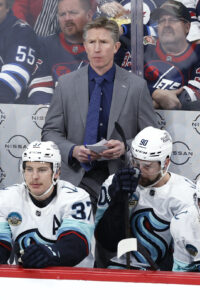The offseason has arrived for three-quarters of the NHL for teams that either missed the playoffs or were eliminated in the first round. Accordingly, it’s now time to examine what they will need to accomplish over the coming months. Next up is a look at Montreal.
With the Canadiens still in the build-up portion of their rebuild, expectations were still low heading into the season. They finished in the same spot as the year before – 28th – while making marginal improvements in goals, goals allowed, and points. With them now missing the postseason three years in a row after making the Cup Final, expectations should start to creep higher now with the team likely to try to emerge from its rebuild soon. Accordingly, GM Kent Hughes will likely be looking to make some moves both for the future and next season.
Clear Defensive Logjam
The Canadiens have one of the deeper defensive groups in the league when it comes to team depth. They’re only a year removed from dressing four (and sometimes five) rookies in a game but until the next wave was ready to push for playing time, they didn’t necessarily have to make a move.
That next wave is now pretty close to being ready. Jayden Struble was expected to be in the minors this season but wound up playing 56 games with the big club. Lane Hutson and Logan Mailloux both received a taste of NHL action down the stretch and held their own. David Reinbacher, the fifth-overall pick last spring, will play full-time in North America next season and should see a handful of games at a minimum.
A total of eight blueliners played at least 44 games for Montreal this season. All are either under contract or controllable through restricted free agency. Even without the prospects being on the verge of pushing for roster spots, there was already a bit of a logjam. But if they think one of Hutson or Mailloux is ready for full-time duty or close to it, they might be inclined to look at moving two of their blueliners.
Some expect David Savard, a 2025 unrestricted free agent, to be moved but they could elect to hold him until closer to the trade deadline to keep him working with the young core as long as possible. At first glance, Jordan Harris could be the odd one out. The 23-year-old can play on both sides, is signed for one more year at an affordable $1.4MM, and can log upwards of 18 minutes a night. Speculatively, Justin Barron could also be in play as he’s now waiver-eligible and can’t be returned to the minors as he was for most of the second half of this season. A pending RFA, the 22-year-old was a former first-rounder and has close to 100 career NHL games under his belt which should give him good value if they decide to move him.
Extension Discussions
Last offseason, the focus was on Cole Caufield’s contract as he was entering RFA eligibility for the first time. They don’t have anyone quite as impactful needing a new deal this time around which should position Hughes to turn his focus to trying to sign a pair of key youngsters to early extensions.
 At the beginning of the season, Juraj Slafkovsky struggled mightily to the point where many felt he should have been assigned to the minors. Instead, Montreal went the other way and put him on the top line and things clicked for him from there. The top pick in 2022 went on to put up 35 points in the final 40 games of the season, moving him from a sure-fire bridge candidate to one they’ll likely try to sign long-term. Given Montreal’s salary structure, it’s reasonable to infer they’d prefer to slot him behind Nick Suzuki whose deal checks in at $7.875MM per season. However, with what first-overall picks typically get on long-term agreements (generally more than this), will he be amenable to that or will he push for more? If it’s the latter, it wouldn’t be surprising to see the two sides wait until the 2025 offseason to see if his second half was an outlier or a sign of things to come.
At the beginning of the season, Juraj Slafkovsky struggled mightily to the point where many felt he should have been assigned to the minors. Instead, Montreal went the other way and put him on the top line and things clicked for him from there. The top pick in 2022 went on to put up 35 points in the final 40 games of the season, moving him from a sure-fire bridge candidate to one they’ll likely try to sign long-term. Given Montreal’s salary structure, it’s reasonable to infer they’d prefer to slot him behind Nick Suzuki whose deal checks in at $7.875MM per season. However, with what first-overall picks typically get on long-term agreements (generally more than this), will he be amenable to that or will he push for more? If it’s the latter, it wouldn’t be surprising to see the two sides wait until the 2025 offseason to see if his second half was an outlier or a sign of things to come.
The other notable extension-eligible candidate is Kaiden Guhle. The 22-year-old blueliner made the jump from junior two years ago and has logged over 20 minutes a night in his first two seasons. With a bit of a limited offensive game, his earnings ceiling will be limited but he could still push past $6MM per season on a max-term deal. Having said that, Guhle has battled injuries both years so an extension would be somewhat of a shared risk scenario. Guhle would be risking leaving some money on the table if he’s able to stay healthy and have a big year next season while Montreal would be risking a significant commitment to a thus-far injury-prone player but if he stays healthy, they could potentially get him at a team-friendly rate. Seeing if there’s a number where both sides are content should be fairly high on the to-do list.
Add Scoring Help
The last time Montreal finished in the top half of the league in goals scored was back in 2018-19. They’ve finished 26th the last two seasons and 27th the year before that. Only two players scored more than 20 goals this season, Suzuki and Caufield. Even if they feel the top line from the second half of the year (those two with Slafkovsky) is a legitimate top trio, they need a lot of secondary scoring behind them.
The return of Kirby Dach should help after he missed almost the entire season with a knee injury while they will bank on Alex Newhook taking another step forward in his development. Accordingly, it’s reasonable for them to hope that some improvement will come internally. That said, internal improvement alone won’t be enough to propel them back into a playoff race let alone the actual playoffs.
Under this management group, the Canadiens have avoided adding players in free agency, preferring to build via the trade market. They’ve flipped a first-round pick in back-to-back years to add Dach and Newhook and, armed with an extra first-rounder again for next month’s draft, many expect them to do so again, whether that’s for another player of that ilk or as part of a bigger swing.
Beyond that, this might be the time for them to look at a shorter-term unrestricted free agent as well, one that can augment the scoring depth for a few years and serve as somewhat of a mentor to what is a fairly young group. Having said that, they will have a decision to make before July 1st if they intend to go that route.
Escape Or Utilize LTIR
Two years ago, Montreal elected to go into offseason LTIR, giving them the flexibility to take on Sean Monahan from Calgary, receiving a 2025 first-round pick for their troubles. That worked out well for the Canadiens considering they signed him to a cheap one-year deal last spring and then flipped him for another first-rounder earlier this season.
Last summer, they elected not to do that, instead waiting until in-season to put Carey Price on LTIR. That move gave them more flexibility but they then didn’t do much of anything with that flexibility.
Accordingly, that might not be the best approach to take this time around. Price still has two years left on his $10.5MM contract although his playing days are over. Flipping him will be difficult considering there is still $11MM in signing bonuses still left to be paid on it.
So, Hughes needs to determine if he wants to go back into offseason LTIR or not. If he does, they could be players either in free agency or perhaps taking on a short-term pricey contract as they did with Monahan two years ago. Even with the cap set to rise by more than $1MM this time around, there will be teams looking to move out some salary. The benefit would be more future than current as they’d likely be compensated with a draft pick but if they’re not in a spot where they think they can push for a playoff spot – which would be a lofty goal – then they wouldn’t be concerned about that.
If they don’t want to go into offseason LTIR, it might be worth them trying to dip out of it altogether. They currently have about $78.6MM in commitments, per CapFriendly, with Barron and Arber Xhekaj being the only two RFAs on the roster who could command a seven-figure contract. That would still leave them room to try to add a piece while also staying under the cap ceiling (meaning Price would be on regular IR), allowing them to bank money for in-season flexibility or to try to avoid incurring a seven-figure bonus overage for the third straight year, a move that would help them cap-wise heading into 2025-26. They’ll want to have their direction picked out by the time free agency opens up.
Photo courtesy of USA Today Sports Images.

